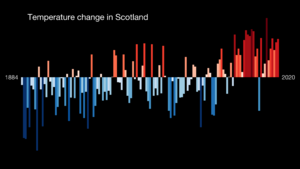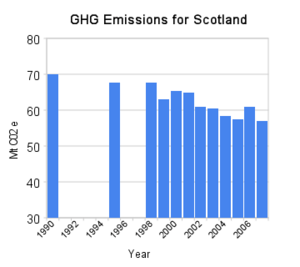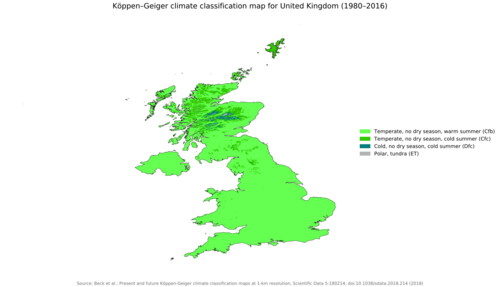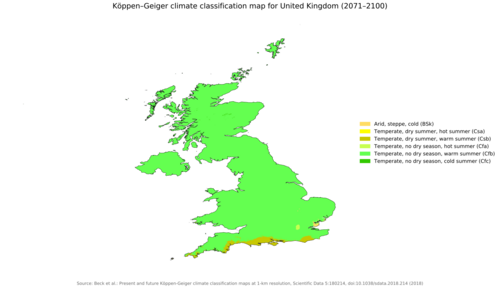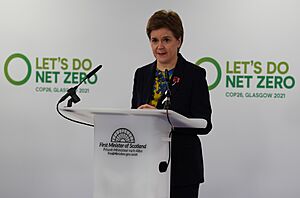Climate change in Scotland facts for kids
Climate change in Scotland means that Scotland's weather and environment are changing. These changes are affecting everything from plants and animals to how people live. The Scottish Parliament is working on ways to slow down climate change and help Scotland get ready for its effects.
What are Greenhouse Gas Emissions?
Greenhouse gases are like a blanket around the Earth. They trap heat and warm the planet. Scotland produces some of these gases. In 2003, Scotland's share was about 10% of the UK's total.
A big part of these gases comes from making energy (37%). Another part comes from transport, like cars and buses (17%). Scotland has been working to reduce these gases. Between 1990 and 2007, the total amount of gases went down by almost 19%. Industries and the public sector made the biggest cuts.
How Climate Change Affects Nature
Changes in Weather
In Scotland, we are already seeing warmer temperatures. There is also more rain and less snow. These changes affect when plants grow, when birds migrate, and when animals have their young. They also change how many different types of plants and animals live in Scotland.
Impact on Ecosystems
We have already seen how climate change affects nature. For example, spring events like leaves opening, birds flying south, and eggs hatching are happening earlier. Some animals and plants might struggle to adapt quickly enough.
New types of plants and animals might move to Scotland as the climate changes. But species that live only on high mountains might disappear from Scotland.
Climate change could seriously harm biodiversity, which means the variety of life. Some plants and animals might not be able to adapt fast enough. They could die out or be replaced by other species. Coastal areas, like sandy beaches called machairs, might disappear because of rising sea levels.
Salmon need clean rivers to lay their eggs. But flash floods caused by heavy rain could destroy these areas. This would harm salmon populations. New risks, like harmful pests and diseases, could also appear.
All these changes, along with how humans use land, could change Scotland's natural environments a lot.
How Climate Change Affects People
Impact on Farming
Climate change could bring some good changes for Scottish farming. Warmer and drier summers might mean bigger harvests. Farmers might even be able to grow new types of crops.
However, there are also challenges. Hot weather could make the soil less healthy. A lack of fresh water could be a problem for farm animals. Warmer, wetter conditions could also bring new diseases to livestock. For example, diseases like West Nile virus or bluetongue could become more common.
What Scotland is Doing About Climate Change
Rules and Laws
Climate Change Act
The Climate Change (Scotland) Act 2009 is a law passed by the Scottish Parliament. It set a goal to reduce Scotland's greenhouse gas emissions by at least 80% by 2050, compared to 1990 levels.
Later, in 2019, this law was updated. Scotland now aims to reach "net zero" emissions by 2045. This means Scotland will remove as many greenhouse gases from the air as it puts in. The law also sets yearly goals for reducing emissions.
The Act also created the Scottish Committee on Climate Change. This group advises the government on how to reach its targets. Scottish government leaders must report on their progress. Since 2011, public organizations in Scotland must follow new rules to help fight climate change.
Protecting the Environment
The Scottish Environment Protection Agency (SEPA) is Scotland's main environmental watchdog. Its job is to protect and improve Scotland's natural environment. SEPA helps communities and businesses understand their duties to the environment.
SEPA believes climate change is the biggest threat to our future. They have their own plan to reduce their carbon emissions. SEPA works with other government groups like Scottish Natural Heritage (SNH) and Forestry and Land Scotland (FLS). In 2009, these groups made a joint statement saying: "The Scientific evidence is now overwhelming: climate change presents very serious global risks and it demands an urgent global response".
Planting Trees
Planting more trees, also known as afforestation, is another way Scotland is fighting climate change. Trees help by absorbing carbon dioxide, a major greenhouse gas, from the air.
Energy
Scotland is also working hard to use more renewable energy. This means energy from sources like wind and water, which do not produce greenhouse gases. This helps reduce the amount of fossil fuels burned for power.
Working with Other Countries
Scotland works with other countries to tackle climate change. For example, in 2017, the First Minister of Scotland, Nicola Sturgeon, visited the United States. She met the Governor of California, Jerry Brown. They both signed an agreement to work together on climate change.
In 2021, a big international climate meeting called COP26 was held in Glasgow, Scotland. Leaders from all over the world came together to discuss climate action.


